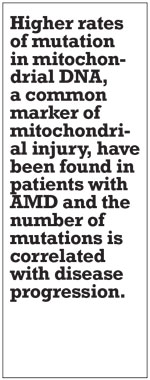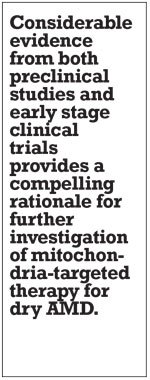Take-home Points
|
 |
|
Bio DISCLOSURES: Dr. Allingham has received research funding from Stealth Biotherapeutics and has served as a subinvestigator for the ReCLAIM-1 and ReCLAIM-2 trials of elamipretide. |
In advanced dry age-related macular degeneration, in which subfoveal photoreceptors and retinal pigment epithelial cells are lost, profound central vision loss results. However, even patients with earlier stages of dry AMD, such as high-risk drusen or noncentral geographic atrophy, experience significant visual dysfunction despite preserved best corrected visual acuity.
Manifestations of visual dysfunction in this population include difficulty with low- light vision and reading, poor adaptation to changes in lighting and impaired low-light activities of daily living. These problems can be quantified as loss of low-luminance visual acuity (LLVA) and low-luminance reading acuity (LLRA). Recently, the mitochondrion has emerged as a promising therapeutic target for the treatment of dry AMD.
Mitochondria emerge as target
Mitochondria are the cellular organelles that provide energy in the form of adenosine triphosphate (ATP). While glycolysis generates the majority of cellular ATP, mitochondria are frequently required to provide ATP for specific, critical and/or high-energy cellular activities.
In addition to their role in cellular energetics, mitochondria act as signaling nodes in a variety of pathways, most notably reactive oxygen species (ROS) and calcium regulation. Mitochondrial dysfunction is associated with ATP loss, increased production of ROS, calcium dysregulation and, in some cases, cell death.
AMD is a complex disease with multiple risk factors contributing to disease in each individual. Well-documented risk factors include age, heredity and environmental risk factors, most famously cigarette smoking.
Several lines of reasoning point to mitochondrial dysfunction as a major mediator of dry AMD. Evidence of mitochondrial dysfunction in AMD ranges from analyses of postmortem tissues demonstrating a reduction in mitochondria and abnormal mitochondrial morphology in RPE isolated from patients with AMD compared with age-matched controls.1
In addition, some inherited mitochondrial diseases, such as maternal-inherited diabetes and deafness, and mitochondrial encephalopathy, lactic acidosis and stroke-like episodes (MELAS), are known to manifest as macular atrophy and other findings also seen in AMD.2,3
 |
| A rendering of the exterior of mitochondria. (National Institutes of Health) |
Compelling preclinical evidence
Compelling preclinical evidence from both tissue culture and animal models supports mitochondria as a target in AMD. For instance, higher rates of mutation in mitochondrial DNA, a common marker of mitochondrial injury, have been found in patients with AMD and the number of mutations is correlated with disease progression.4
Cigarette smoking is a well-documented major environmental risk factor for development and progression of AMD. Hydroquinone is a major toxin contained in cigarette smoke, plastics and processed foods, and is well characterized as a mitochondrial toxicant. Both cigarette smoke and hydroquinone exposure have been found to cause the development of drusen-like deposits in mice, suggesting a causative role for mitochondrial injury in AMD pathogenesis.5
Furthermore, mitochondrial dysfunction is a prominent feature in one of the best studied mouse models of dry AMD, the APOE4 -/- mouse.6 On electroretinogram, RPE in these mice display multiple markers of mitochondrial dysfunction, development of sub-RPE deposits resembling drusen and visual dysfunction.
 |
Emerging therapeutic candidates
Interestingly, treatment with subcutaneously elamipretide (Stealth Biotherapeutics), a drug currently in development for dry AMD, reversed RPE morphological changes, sub-RPE deposits and visual dysfunction.6 Elamipretide is a cell-permeable peptide delivered via a 40-mg subcutaneous injection that targets mitochondrial dysfunction.
Risuteganib (Allegro Ophthalmics) is another promising drug under investigation for dry AMD as well as other retinal
indications such as diabetic macular edema. Risuteganib, an integrin antagonist, is
reported to have multiple mechanisms of action including mitochondrial protection.
Risuteganib has been shown to prevent mitochondrial injury in cultured RPE cells exposed to hydroquinone, suggesting that mitochondrial protection is efficacious in an in vitro model of AMD.7 Additionally, risuteganib was found to reduce mitochondrial ROS and improve mitochondrial bioenergetics in cultured RPE.8
On the basis of these preclinical data, both elamipretide and risuteganib have advanced to human trials and have completed early stage clinical studies showing promising signs of efficacy in patients with dry AMD.
 |
Elamipretide results
The ReCLAIM study (n=40, NCT02848313) was a Phase I, single-site, open-label clinical trial that evaluated the safety and tolerability of subcutaneous elamipretide in subjects with dry AMD. This study included two prespecified subgroups: patients with noncentral (NC) GA (n=19); and those with high-risk drusen (HRD) without GA (n=21). Subjects were required to demonstrate at least a 5-letter LLVA deficit and to endorse LL deficits on a LL questionnaire.
All subjects received daily subcutaneous elamipretide (40 mg). Outcomes were assessed at week 24 following initiation of the study drug. Subcutaneous elamipretide was generally safe and well-tolerated with no treatment-related serious adverse events. The most common adverse events were injection-site reactions including pruritis, erythema and induration.
The NCGA subgroup demonstrated a mean increase in BCVA of 4.6±5.1 letters from baseline (p=0.003), with a mean increase in LLVA of 5.4±7.9 letters from baseline (p=0.025). This group also demonstrated a significant increase in LLRA of logMAR -0.52±0.75 (p<0.017), representing a 5-line gain from baseline. In this subgroup, the mean change in GA square-root area was 0.13±0.14 mm measured by optical coherence tomography. This was less than the 24-week rate of growth observed in natural history studies and placebo control arms of clinical trials for GA.
The HRD subgroup demonstrated a mean increase in BCVA of 3.6±6.4 letters from baseline (p=0.025), with a mean increase in LLVA of 5.6±7.8 letters from baseline (p=0.006). At week 24, these patients had a modest but significant mean increase in BCRA of logMAR -0.11±0.15 (p=0.005), corresponding to approximately a 1-line gain from baseline. Investigators also observed a significant mean increase in LLRA of logMAR -0.28±0.17 (p=0.0001), which equates to a 3-line gain vs. baseline.
Currently, ReCLAIM-2 (NCT03891875), a Phase IIb multicentered randomized trial, is underway to further evaluate elamipretide for slowing growth of GA lesion size as well as improving standard and low-luminance vision outcomes.
Early risuteganib outcomes
Risuteganib, also known as luminate, is the subject of a completed Phase II randomized trial of patients with intermediate dry AMD (n=42). This 32-week study enrolled 40 subjects with 25 receiving intravitreal risuteganib 1 mg and 15 receiving sham treatment. Subjects had intermediate dry AMD.
The primary endpoint was the percent of subjects experiencing a clinically significant 8-letter gain in BCVA at week 24 for treated patients and at week 12 for sham. Secondary endpoints included low-luminance deficit, color vision, rate of conversion to exudative AMD, morphology on optical coherence tomography and microperimetry as well as mean BCVA between cohorts.
Risuteganib was well-tolerated with no drug-related serious adverse events reported. Preliminary results reported the study met its primary endpoint, demonstrating an 8-letter gain in BCVA in 48 percent of treated subjects compared with 7.1 percent in the sham control arm (p=0.013).
Risuteganib is not currently recruiting for an AMD indication, but given the positive Phase II findings, the company says it’s planning a follow-on Phase III study.
Bottom line
Considerable evidence from both preclinical studies and early stage clinical trials provides a compelling rationale for further investigation of mitochondria-targeted therapy for dry AMD. Two trials in patients with dry AMD have demonstrated improved visual function in addition to signals suggesting improvement in anatomic outcomes such as GA lesion size. Improvement in vision outcomes represents an important paradigm shift in therapy goals for dry AMD and would address a major unmet clinical need in a large body of patients for whom there is currently no effective therapy. RS
REFERENCES
1. Bianchi E, Scarinci F, Ripandelli G, et al. Retinal pigment epithelium, age-related macular degeneration and neurotrophic keratouveitis. Int J Mol Med. 2013;31:232-242.
2. Rummelt V, Folberg R, Ionasescu V, Yi H, Moore KC. Ocular pathology of MELAS syndrome with mitochondrial DNA nucleotide 3243 point mutation. Ophthalmology. 1993;100:1757-1766.
3. Smith PR, Bain SC, Good PA, et al. Pigmentary retinal dystrophy and the syndrome of maternally inherited diabetes and deafness caused by the mitochondrial DNA 3243 tRNA(Leu) A to G mutation. Ophthalmology. 1999;106:1101-1108.
4. Terluk MR, Kapphahn RJ, Soukup LM, et al. Investigating mitochondria as a target for treating age-related macular degeneration. J Neurosci. 2015;35:7304-7311.
5. Espinosa-Heidmann DG, Suner IJ, Catanuto P, Hernandez EP, Marin-Castano ME, Cousins SW. Cigarette smoke-related oxidants and the development of sub-RPE deposits in an experimental animal model of dry AMD. Invest Ophthalmol Vis Sci. 2006;47:729-737.
6. Cousins SW, Saloupis P, Brahmajoti MV, Mettu PS. Mitochondrial dysfunction in experimental mouse models of subRPE deposit formation and reversal by the mito-reparative drug MTP-131. Invest Ophthalmol Vis Sci. 2016;57:2126.
7. Yang P, Shao Z, Besley NA, et al. Risuteganib protects against hydroquinone–induced injury in human RPE cells. Investig Opthalmology Vis Sci. 2020;61:35.
8. Zhou D, Chwa M, Shao Z, et al. Mechanism of action of risuteganib for retinal diseases through protection of retinal pigment epithelium (RPE) and enhancement of mitochondrial functions. Invest Ophthalmol Vis Sci. 2020;61:4949.



